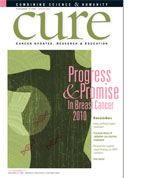Publication
Article
CURE
Under Reconstruction
Author(s):
Surgeons disagree on whether nipple-sparing surgery has benefits.
At 59, Andrea Ziltzer’s mother was diagnosed with breast cancer. A year later, she died. Of course, there are no words to describe the agony of losing a mother, but in Ziltzer’s case, it also forced her to make several decisions regarding her own health.
The Westchester, New York, mother of two didn’t know whether her mother carried either of the two genetic mutations for breast cancer, BRCA1 or BRCA2, but she decided to be tested. She learned at age 45 that she carried the BRCA2 mutation.
Then she made another decision: to have a preemptive prophylactic mastectomy. “Getting tested was a much harder decision to make than deciding whether to get a mastectomy,” Ziltzer says. “I was much more scared of cancer than any operation.”
After extensive research, Ziltzer picked a one-step, nipple-sparing mastectomy in which the breast tissue is removed and replaced with an implant. In traditional reconstruction, the nipple and areolar are removed and recreated.
The nipple-sparing surgery is still uncommon and lacks consensus among breast surgeons, but it is becoming increasingly popular among health consumers as they look for less invasive options.
The main concern of opponents revolves around the fact that the nipple complex is rich in breast ducts from which most breast cancers arise. What health professionals agree on is that the pool of candidates for nipple-sparing surgery is small and falls into three major groups:
> Cancer-free women who are considering a mastectomy as a preventive measure.
> Women with small breast cancer tumors that are not located in danger zones near the nipple.
> Women whose doctors have biopsied the breast tissue and determined that the locations of tumors do not pose risks for the nipple-sparing procedure.
Typically, the nipple and areola are removed along with the breast tissue for reconstruction because traditionalists worry about them harboring cancer cells. One study showed tumor cells in about 20 percent of mastectomy specimens done for breast cancer, but no tumor cells were found in cases of prophylactic removal. But in recent years, researchers have revisited the danger of cancer cells lurking in the nipples or nearby tissue—and whether the risk is low enough to leave them.
The results have been mixed. One study by the Cleveland Clinic found very low rates of recurrence in 149 nipple-sparing mastectomies it performed between 2001 and 2007. Another by the Memorial Sloan-Kettering Cancer Center had similar results, with doctors concluding that the procedure could lead to excellent results with the right candidates.
This has revolutionized reconstructive surgery.
The two- to three-hour operation, with the official name of “total nipple areolar sparing with direct-to-implant reconstruction,” is a process where implants are immediately inserted after the mastectomy, according to C. Andrew Salzberg, MD, a pioneer of the surgery and chief of plastic surgery at Dobbs Ferry Hospital in New York.
“This has revolutionized reconstructive surgery,” says Salzberg, who has done 800 procedures in the past nine years. “And it has made the decision of having a mastectomy much easier for some patients because they will know they’ll look just as good—or better—almost immediately.”
However, some physicians fret that the study groups have not been large or controlled enough to give the procedure a green light.
Sally Knox, MD, a breast surgeon at Baylor University Medical Center in Dallas, says she hasn’t adopted the procedure primarily because she hasn’t seen the need.
“We are doing areola sparing, and we can save the pigment, and the plastic surgeons build a nipple that looks great,” she says. “Why save the tip of the nipple where all the ducts converge if you are getting a good cosmetic result?”
Knox says that no sensation is saved in the nipple-sparing procedure, which means the only difference is that the woman is saving the nipple and has all her own skin for the possibility of an improved cosmetic appearance.
“Some surgeons will love it, and others won’t,” she adds. “The ladies should talk over the benefit and risk with their surgeons.”
Ziltzer says the initial recovery “was not a piece of cake.” But as the healing began, “it was absolutely manageable.” And even though the immediate post-surgery look is “really unattractive,” Ziltzer says it’s a process.
Eventually, she felt she looked better than before the mastectomy.





